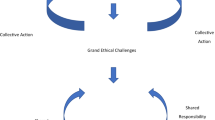Abstract
Pennsylvania sits atop the Marcellus Shale, a reservoir of natural gas that was untapped until the 2004 introduction of unconventional natural gas drilling operations (UNGDO) in the state. Colloquially known as fracking, UNGDO is a controversial process that employs large volumes of water to fracture the shale and capture gas; it has become a multi-billion dollar industry in Pennsylvania. We analyzed letters to the editor of the most widely circulated local newspaper in the most heavily drilled county in Pennsylvania (Bradford County) in order to characterize residents’ concerns and their involvement in popular epidemiology—the process by which citizens investigate risks associated with a perceived environmental threat. We reviewed 215 letters to the editor that referenced natural gas operations and were published by The Daily Review between January 1, 2008 and June 8, 2013. We used NVivo 10 to code and analyze letters and identify major themes. Nvivo is qualitative data analysis software (http://www.qsrinternational.com/products_nvivo.aspx) that allows researchers to code and analyze “unstructured” data, including text files of any type (e.g., interview transcripts, news articles, letters, archival materials) as well as photographs and videos. Nvivo can be used to classify, sort, query, comment on, and share data across a research group. Letters demonstrated citizen engagement in beginning and intermediate stages of lay epidemiology, as well as discord and stress regarding four main issues: socio-economic impacts, perceived threats to water, population growth and implications, and changes to the rural landscape. Residents called for stronger scientific evidence and a balance of economic development and health and environmental protections. Citizens’ distress regarding UNGDO appeared to be exacerbated by a dearth of information to guide economic growth and health, environmental, and social concerns. This analysis proposes locally informed questions to guide future surveillance and research.
Similar content being viewed by others
References
Drilling for Natural Gas in the Marcellus Shale Formation—Frequently Asked Questions. (2014). http://files.dep.state.pa.us/OilGas/BOGM/BOGMPortalFiles/MarcellusShale/MarcellusFAQ.pdf. Accessed January 22, 2014.
Pennsylvania’s First Shale Driller: Range Resources. http://stateimpact.npr.org/pennsylvania/topic/range-resources/. Accessed October 25, 2013.
Considine, T., Watson, R., & Blumsack, S. (2011). The Pennsylvania Marcellus Natural Gas Industry: Status, economic impacts and future potential. http://marcelluscoalition.org/wp-content/uploads/2011/07/Final-2011-PA-Marcellus-Economic-Impacts.pdf. Accessed January 22, 2014.
Finkel, M., & Law, A. (2011). The rush to drill for natural gas: A public health cautionary tale. American Journal of Public Health, 101(5), 784–785.
Colborn, T., Kwiatkowski, C., Schultz, K., & Bachran, M. (2011). Natural gas operations from a public health perspective. Human and Ecological Risk Assessment International Journal, 17(5), 1039–1056.
Mitka, M. (2012). Rigorous evidence slim for determining health risks from natural gas fracking. JAMA, 307(20), 2135–2136.
DiGiulio, D. C., Wilkin, R. T., Miller, C., & Oberley, G. (2011). Draft—Investigation of Ground Water Contamination near Pavillion, Wyoming. http://www2.epa.gov/sites/production/files/documents/EPA_ReportOnPavillion_Dec-8-2011.pdf. Accessed January 23, 2014.
Bamberger, M., & Oswald, R. (2012). Impacts of gas drilling on human and animal health. Solutions Journal of Environmental Occupational Health Policy NS, 22(1), 51–77.
Ferrar, K., Kriesky, J., Christen, C., Marshall, L., Malone, S., & Sharma, R. (2013). Assessment and longitudinal analysis of health impacts and stressors perceived to result from unconventional shale gas development in the marcellus shale region. International Journal of Occupational and Environmental Health, 19(2), 104–112.
Goldstein, B., Kriesky, J., & Pavliakova, B. (2012). Missing from the table: role of the environmental public health community in governmental advisory commissions related to marcellus shale drilling. Environmental Health Perspectives, 120(4), 483–486.
Cuzisk, M. (2013). Marcellus Shale Gas Production Numbers Surge. http://stateimpact.npr.org/pennsylvania/2013/08/19/marcellus-shale-gas-production-numbers-surge/. Accessed October 27, 2013.
Brown, P. (1992). Popular epidemiology and toxic-waste contamination—Lay and professional ways of knowing. Journal of Health and Social Behavior, 33(3), 267–281.
Standard Rate & Data Service (SRDS). http://www.srds.com. Accessed January 23, 2014.
Giacomini, M. K., & Cook, D. J. (2000). Users’ guides to the medical literature: XXIII. Qualitative research in health care A. Are the results of the study valid? Evidence-based medicine working Group. JAMA, 284(3), 357–362.
Giacomini, M. K., & Cook, D. J. (2000). Users’ guides to the medical literature: XXIII. Qualitative research in health care B. What are the results and how do they help me care for my patients? Evidence-based medicine working group. JAMA, 284(4), 478–482.
Mays, N., & Pope, C. (2000). Qualitative research in health care. Assessing quality in qualitative research. BMJ, 320(7226), 50–52.
Pope, C., & Mays, N. (Eds.). (2000). Qualitative research in health care. London: BMJ Books.
PA DEP Oil & Gas Reporting Website—Statewide Data Downloads by Reporting Period. http://www.paoilandgasreporting.state.pa.us/publicreports/Modules/DataExports/DataExports.aspx. Accessed January 16, 2014.
Sacavage, K. (2013). Overview of Impact Fee Act, Act 13 of 2012. http://www.puc.state.pa.us/NaturalGas/pdf/MarcellusShale/Act13_Implementation_Presentation.pdf. Accessed January 14, 2014.
Dimock, PA. (2014): “Ground Zero” In the fight over fracking. http://stateimpact.npr.org/pennsylvania/topic/dimock/. Accessed January 14,
Cusick, M. (2013). Economists question Corbett’s Marcellus Shale jobs claims. http://stateimpact.npr.org/pennsylvania/2013/11/06/economists-question-corbetts-marcellus-shale-jobs-claims/. Accessed January 15, 2014.
EXPRESS-TIMES opinion staff. (2014). EDITORIAL: Pa. needs a public health registry to track effects of fracking. http://www.lehighvalleylive.com/opinion/index.ssf/2014/07/editorial_23.html. Accessed October 31, 2014.
Pupovac, J. (2012). Towanda by the numbers. http://stateimpact.npr.org/pennsylvania/2012/12/11/towanda-by-the-numbers/. Accessed January 14, 2014.
Renko, A. (2011). Crime rising in bradford county. http://thedailyreview.com/news/crime-rising-in-bradford-county-1.1180649. Accessed January 23, 2014.
Amico, C., DeBelius, D., Detrow, S., & Stiles, M. (2014)Shale Play: Natural Gas Fracking in Pennsylvania. http://stateimpact.npr.org/pennsylvania/drilling/. Accessed January 16, .
Slonecker, E., Milheim, L., Roig-Silva, C., Malizia, A., Marr, D., & Fisher, G. (2012). Landscape consequences of natural gas extraction in bradford and washington counties, pennsylvania, 2004–2010. http://pubs.usgs.gov/of/2012/1154/of2012-1154.pdf. Accessed January 21, 2014.
Zyla, G. Personal communication with M Powers.
Exemption of Oil and Gas Exploration and Production Wastes from Federal Hazardous Waste Regulations. (2002). http://www.epa.gov/osw/nonhaz/industrial/special/oil/oil-gas.pdf. Accessed January 21, 2012.
Natural Gas Extraction—Hydraulic Fracturing. (2013). http://www2.epa.gov/hydraulicfracturing. Accessed January 21, 2014.
Legere, L. (2012). DEP lets Cabot resume Dimock fracking. http://thetimes-tribune.com/news/dep-lets-cabot-resume-dimock-fracking-1.1361871. Accessed January 21, 2014.
Acknowledgments
We thank Lauris Olson, Van Pelt reference librarian, and Greg Zyla, publisher of The Daily Review, for their assistance. This was an unfunded research project.
Author information
Authors and Affiliations
Corresponding author
Rights and permissions
About this article
Cite this article
Powers, M., Saberi, P., Pepino, R. et al. Popular Epidemiology and “Fracking”: Citizens’ Concerns Regarding the Economic, Environmental, Health and Social Impacts of Unconventional Natural Gas Drilling Operations. J Community Health 40, 534–541 (2015). https://doi.org/10.1007/s10900-014-9968-x
Published:
Issue Date:
DOI: https://doi.org/10.1007/s10900-014-9968-x




